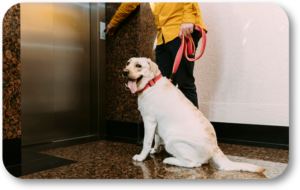I was in Atlanta last Thursday working with a new Home Dog Training client and his three year old Doberman Pinscher named Wally. Like most Dobermans, Wally was a pretty mellow and somewhat goofy dog. Our client lived in a high rise condo and Wally was very good in that he didn’t bark in the condo and was very well potty trained. Besides the normal obedience issues that we quickly addressed, Wally had one problem that, in many cases, would not be a big issue at all. Wally was very fearful and reactive when placed in an enclosed environment.

If we were in Cumming or Cleveland or Dahlonega; our client may never have noticed this behavior. Wally would have had a lot of room to run and be free. Even when he would be in the house, he would always have had room to move around to his happy spot and feel fine. The issue that we faced was that the only way for Wally to leave the condo was to take a ten story elevator ride town to the lobby. This was the large issue we needed to address. Robin and I have trained many “high rise” dogs and have faced the need to address this problem quite often. As with our current client, we needed to explain what was really happening with Wally and the solutions that needed to be taken…
The one thing you don’t want to do is to force your dog into a situation where he is placed in a fight or flight situation in a confined environment (i.e. the building elevator). You don’t want to have another dog get in the elevator where you have to move to the corner of the elevator and hold your dog on a very tight leash or pick him up. When you are doing these things, you are sending signals to your dog that something is very wrong and dangerous.
As your dog’s ultimate protector, it is your main job to keep him safe. You are now “telling” your dog that you are a bad leader and don’t have the ability to keep him safe. Because of this, your dog will step up to be the leader and will take a more aggressive role in the elevator. I would not recommend moving towards a situation such as this.
Well, sometimes, the best way to maintain safety is to avoid unsafe situations. This is not “running away”, it is simply making the best choice of what is available. Here are some of my ideas:
- If you are in the elevator and someone with a dog starts to enter, politely mention that your dog gets a little crazy when in confined areas with other dogs. Ask him if he could please wait for the next elevator. If he agrees, thank him. If he still steps into the elevator, excuse yourself and get out of the elevator. If there are other people in the elevator, they will see that you are a responsible dog owner and may stand up for you next time. The important thing is that you have maintained your dog’s safety and your leadership.
- If you are about to enter the elevator and you see that there is another dog in the elevator, stay back and to not go into the elevator. Let the people in the elevator know that your dog is a little fearful of dogs in the elevator and you want to wait for the next one. Again, this will show the people in the elevator that you are a responsible dog owner and respect their rights. It also keeps your dog safe and maintains your leadership.
Sometimes it will take you a few more minutes to go up and down the elevator, but the extra few minutes will do wonders in forming a strong bond with your dog and a good relationship with your building neighbors.
You could also practice going up and down the elevator with your dog. Find a quiet time when people normally aren’t riding the elevator. Take you dog for rides by himself at these times. If your dog has a “doggy buddy” in the building, you could practice riding with him during these “quiet times”. You can switch off between where your dog is in the elevator and his doggie buddy enters and where your dog’s buddy is in the elevator and he enters. Take this exercise slow, because your dog still may have some anxiety about being in an enclosed space. You can also practice the above exercise with “human buddies” that your dog knows and likes.
Dealing with anxiety due to enclosed places is part of canine socialization training. This form of training can not be forced or rushed. The outcome can never be predicted. All you can do is to create an environment where your dog is given the opportunity to feel safe and secure. If he does, that is great. As with people, some dogs “just have a fear of something”. If, after practicing and avoiding conflict, your dog still demonstrates a high level of anxiety, you will have to accept that in order to keep him safe and secure with you and your family.
Avoidance is sometimes the optimum solution. As in the old Vaudeville joke; Patient: “Doctor, it hurts when I do this.” Doctor: “Then don’t do that”.
Please call Robin or me at (770) 718-7704 if you need any dog training help. We are blessed to have been your local dog training experts for over sixteen years. We have trained over 5,000 great dogs and loving families and are ready to help you.

Follow Us!